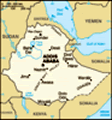Advertisement
Published: July 19th 2019
I thought nothing in Ethiopia would surprise me any more but this morning managed to do just that on two occasions. We were advised that our next tribe visit to see the Dassanech village near Omerate, just over the Omo River, was a similar distance from Turmi to that of the Karo tribe the previous day, a journey which had taken around 2 hours along a windy, dirt road with its share of potholes, so we assumed much the same for this trip. To our total surprise, by the time we were just a few kilometres out of Turmi, we suddenly hit an almost straight, level bitumen road, marked on both sides and the centre, and with virtually not a single blemish the whole 80 kilometres to the village. Thus a potential two hour trip was turned into less than an hour. We were advised that the rationale for this was that the village at Omerate was very close to the Kenyan border and the two countries are trying to develop some joint cultivation initiatives around the Omo River, but at this stage the road, on which we didn’t pass another car on the hour’s trip, seems to be all there
is of this great initiative.
If I were to describe the scenery for most of the trip, I’d classify it as arid and pretty unproductive, but suddenly out of the blue, just as we reached just a few kilometres from Omerate, on one side of the road, built up and with impressive irrigation channels, were acres and acres (or should this be hectares these days?) of some of the healthiest cotton plantations I’ve ever seen. Meanwhile on the other side of the road, at a lower level, continued the same arid landscape. We were advised that these were the cultivations of the Dassanechs and that to irrigate the crops, they have to manually haul buckets of water up from the river (no mean feat in itself) and then carry them along to the fields and tip them into the channels. Talk about a labour intensive operation!
Before making it to the Dassanech village, we had to scramble down the river face onto
local wooden dugout canoes, which transported us for the slow trip across the river. We then had a walk of a couple of kilometres before we hit the village itself, mainly through a sorghum plantation, this and its cotton fields confirming the Dassanech’s reputation as being ‘the cultivation tribe’. The village contained around one hundred huts to house around 350 adults and “I don’t know how many children, because we don’t count them”! These huts were even more basic that most we had seen with the other tribes and most were just sheets of correlated iron bound together by anything available. Anything basic about their housing was more than compensated for by their hospitality. Once again we paid a blanket fee to the village chief to have free range to photograph anything and anyone. And once again, the children couldn’t get in front of the camera enough (and loved checking out the output) and most of the women were also keen to get into the action but the men were very resistant. Fortunately it is the women who tend to stick to traditional tribal costumes while men often mix it up with western clothing. We were amused to see guys
walking around in Man U and Chelsea T-shirts, and our guide informed us they had no idea who these teams were but knew that this clothing was trendy in the western world!
After a speedy return to Turmi for lunch (we did pass two vehicles this time!), we then made our way north for our overnight destination of Jinka. En route, we stopped briefly for the weekly Dimeka markets, which featured not only the Hamar but also a new tribe for us, the Bena. These are not dissimilar to the Hamar people, with the women displaying similar basin cuts, but they tend to wear more clothing than the Hamar women. Similar to the Turmi markets, it seemed more of a social occasion, and there were often large groups sitting under the shade of a huge tree devouring quantities of the locally produced beer.
Only one more tribe visit to go, that of the famous Mursi, the ones where the ladies have a
small plate inserted into their lower lips. Let’s hope they don’t convince us to follow suit!
Advertisement
Tot: 0.1s; Tpl: 0.017s; cc: 12; qc: 29; dbt: 0.0501s; 1; m:domysql w:travelblog (10.17.0.13); sld: 2;
; mem: 1.2mb
























D MJ Binkley
Dave and Merry Jo Binkley
The joys of travel
Making memories.